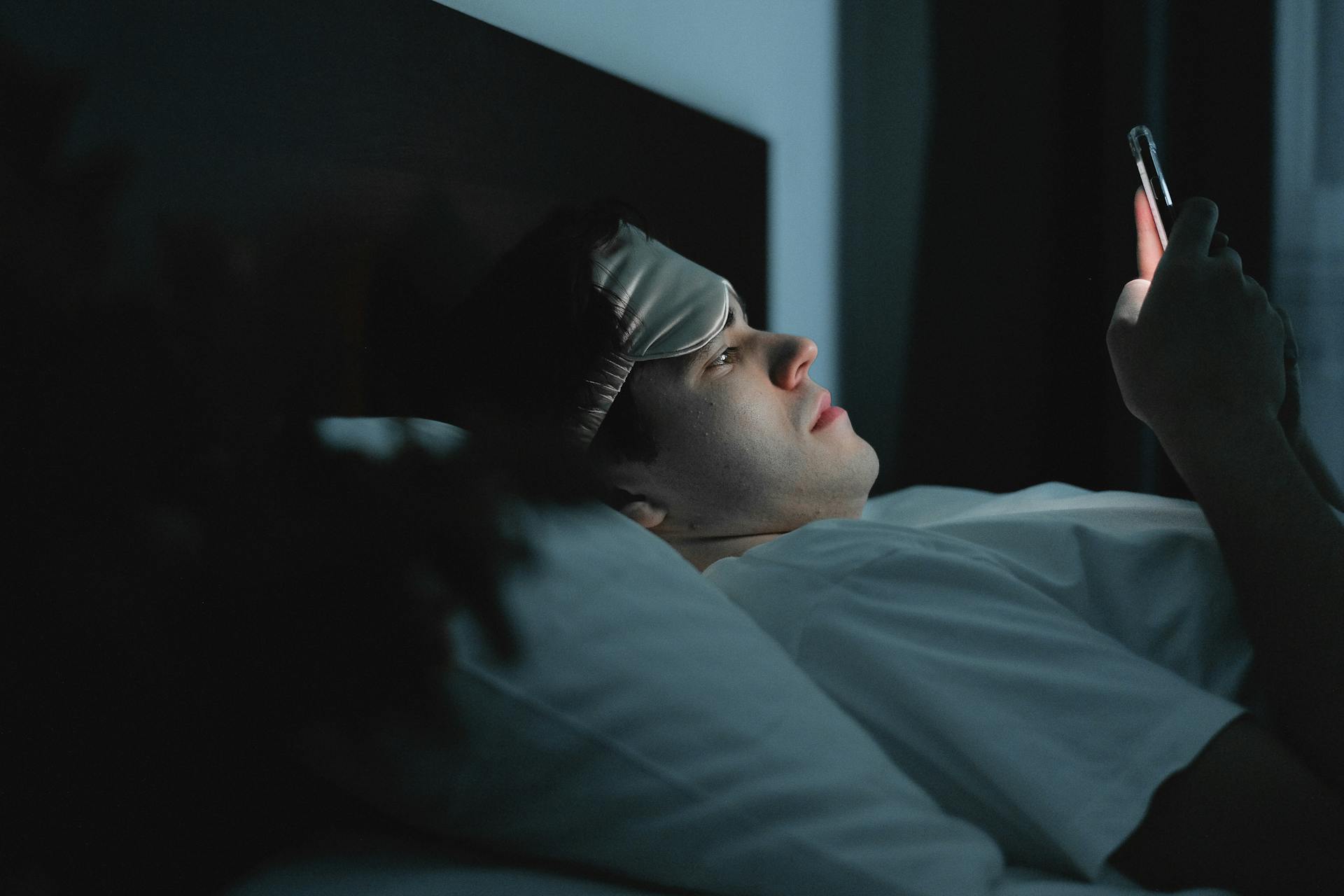
Midnight zoomies are a common phenomenon where cats suddenly become hyperactive and energetic at night. This can be a challenging experience for cat owners who are trying to sleep.
Cats typically exhibit midnight zoomies between 10pm and 2am, with the peak activity usually occurring around midnight. This is often accompanied by rapid movements, jumping, and pouncing.
The exact cause of midnight zoomies is still unknown, but it's believed to be related to a cat's natural instinct to hunt and play. Some experts suggest that it may be triggered by a cat's pent-up energy from a day of relaxation.
As a cat owner, you may have noticed that your cat's midnight zoomies can be unpredictable and exhausting. But don't worry, with a little understanding and patience, you can learn to manage this behavior and get some rest.
Recommended read: Do Big Cats Get Zoomies
What Are Cat Zoomies?
Cat zoomies are a normal behavior where your cat suddenly starts running around the house with high energy, often stopping just as quickly as they started.
This behavior can be quite unexpected and may seem like a switch has flipped, leaving your cat with well-spent energy ready to resume their afternoon nap.
It's not uncommon for cats to experience zoomies, especially after a period of rest or relaxation.
Why Do Cats Get Zoomies?
Cats get zoomies because they're naturally crepuscular, meaning they're active at dawn and dusk, when their natural prey is active. This is when their internal rhythm tells them to get active and start hunting.
Cats tend to be more active when their owners are home, as they've been lounging all day and have energy stored up. This is why they often get zoomies in the evening when their owners are home.
Providing cats with food puzzles, a bird feeder to watch, or other enrichment activities can help calm them down before bedtime. This can be especially helpful for cats that have trouble sleeping.
Giving cats a nice interactive play session in the early evening with a feather wand or other toy can also help them settle down for the night. This usually involves a combination of exercise and a meal.
Stress, excited energy, and lack of exercise are all common reasons why cats get the zoomies. This can manifest as frantic running around the house, often at unexpected times.
You might like: When Do Puppies Grow Out of Zoomies
Pent-up energy is a major contributor to zoomies, as cats need to expend their unused energy after sleeping for most of the day. This is especially true for younger cats, but can affect cats of any age.
Ensuring cats have enough mental and physical stimulation during the day can help prevent zoomies at night. This can be achieved through playtime, exercise, and providing stimulating activities.
When Do They Typically Occur?
Midnight zoomies can occur frequently in the evenings or at night, which can be a sign that your cat hasn’t gotten enough exercise throughout the day.
Zoomies can also result from stressful triggers or lifestyle changes for your cat, such as being scared or experiencing a change in their environment.
If your cat's litterbox is not clean, it can reveal that they're uncomfortable, which may lead to zoomies.
A trip to the litter box can sometimes trigger zoomies, but it's not the only reason they happen.
Excess Energy
Excess Energy is a common issue in indoor cats, leading to those frantic zoomies sessions.
If your cat isn't getting enough exercise, they may release pent-up energy by running wildly around the house.
This excess energy can also be a sign of underlying issues, such as an uncomfortable litter box or lack of exercise throughout the day.
Types
Excess energy can manifest in various forms.
There are three main types of excess energy: kinetic, potential, and thermal.
Kinetic energy is the energy of motion, which can be seen in the vibrations of molecules in a hot cup of coffee, reaching temperatures of up to 98°C.
Potential energy is stored energy, like the energy stored in a stretched rubber band.
Thermal energy is the energy of heat, which can be felt when you touch a warm stove, radiating heat at a rate of 200 watts.
Triggers
Zoomies can be triggered by stressful events like bathtime or moving, causing your cat to release pent-up nerves through frantic running.

After a trip to the litter box, your cat may exhibit zoomies if they're uncomfortable or if their litterbox isn't clean.
Frequent evening or nighttime zoomies can indicate that your cat hasn't gotten enough exercise throughout the day.
Stressful lifestyle changes, such as being scared, can also lead to zoomies in your kitten.
Zoomies can be a sign that your cat needs more physical activity and mental stimulation.
Effects
Excess energy can lead to feelings of restlessness and anxiety, making it difficult to relax and unwind.
The physical effects of excess energy can be just as concerning, causing headaches and fatigue.
In extreme cases, excess energy can even lead to mood swings and irritability.
Regular exercise can help burn off excess energy and improve overall physical and mental well-being.
However, it's essential to find a balance between physical activity and rest to avoid exacerbating the issue.
Preventing Cat Zoomies at Night
Providing your cat with food puzzles can help calm them down before bedtime, as it increases their daytime activity and gives them a mental challenge.
Interactive play sessions in the early evening can also help, especially if you use a feather wand or other 'fishing pole' style toy. This can help expend some of that pent-up energy.
You can try setting a few toys out before bedtime to get that extra energy out, and this can help you get the rest you need.
Giving your cat a nice interactive play session in the early evening with a meal afterwards can help them settle down for the night, usually due to the combination of exercise and food.
In the best-case scenario, cats are just expending some pent-up energy, but ensuring they're physically and mentally exhausted at the end of the day can help prevent the zoomies.
How to Deal with Midnight Zoomies
Midnight zoomies can be a real challenge for cat owners. Providing your cat with food puzzles during the day can help calm them down before bedtime.
Increasing daytime activity through enrichment can help reduce zoomies at night. A bird feeder to watch or some other kind of enrichment can be a good idea.
Interactive play sessions in the early evening with a feather wand or other 'fishing pole' style toy can help your cat settle down for the night. This combination of exercise and a meal usually helps.
Cats need to be physically and mentally exhausted at the end of the day to prevent zoomies. Interactive toys can help with this, as they allow your cat to play and be rewarded for their efforts.
Setting out a few toys before bedtime can help get that extra energy out and give you the rest you deserve.
Frequently Asked Questions
Why does my dog get zoomies at night?
Your dog gets zoomies at night due to excess energy built up from a lack of exercise or being confined to a crate during the day. This pent-up energy is released as soon as your dog gets the chance to run around.
Sources
- https://www.inverse.com/science/39459-why-does-my-cat-run-around-at-night-according-to-science
- https://basepaws.com/blog/exploring-the-nighttime-zoomies-why-do-cats-get-active-at-night
- https://en.wikipedia.org/wiki/Frenetic_random_activity_periods
- https://www.businessinsider.com/guides/pets/cat-zoomies
- https://prydepets.com.au/blogs/news/uncover-the-mystery-behind-your-cats-late-night-zoomies
Featured Images: pexels.com


